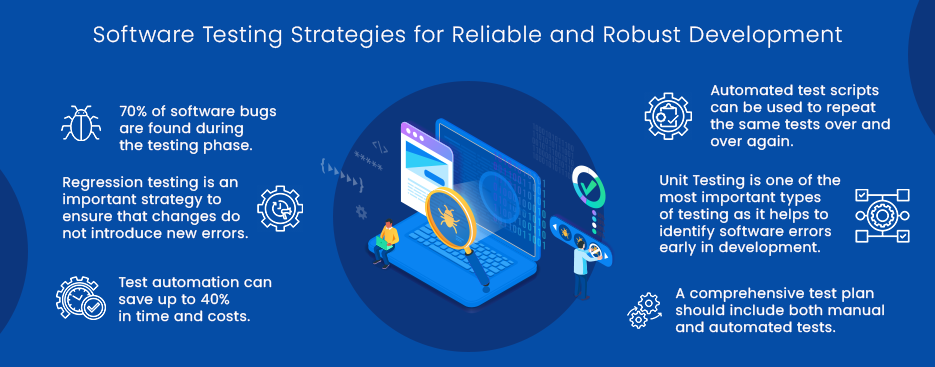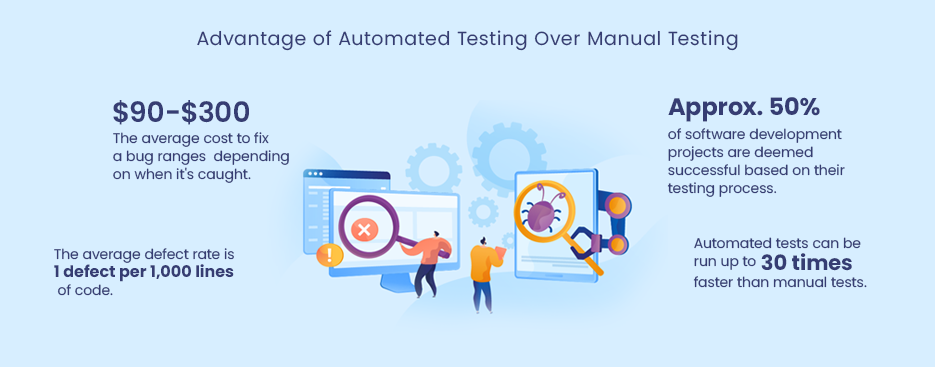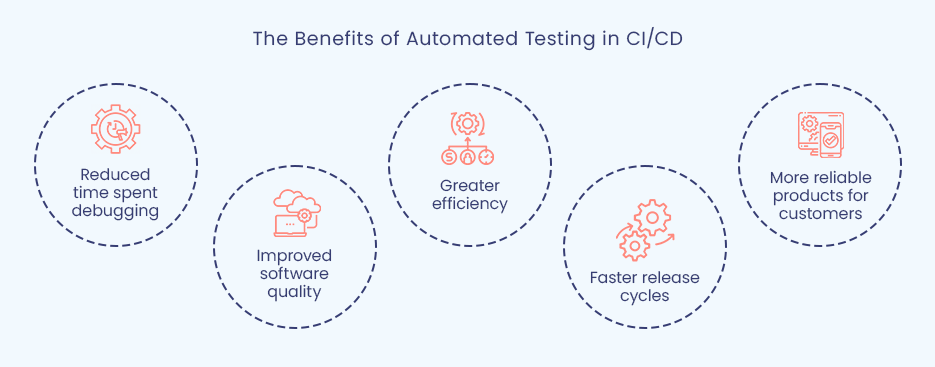Table of Contents
Software testing is an essential part of software development, and the strategies used to test software must be robust and reliable to succeed. However, according to a report from the Standish Group, over 70% of software projects fail due to inadequate testing. As software development project management continues to advance in the coming years, it is increasingly important to ensure that robust and reliable testing strategies are in place to guarantee a high-quality product. By 2025, the global software testing strategies market is expected to reach $49.7 billion, an increase of almost 9% from 2020. As such, developers and testers must stay abreast of the latest software testing strategies to remain competitive.
This article will explore 15 of the most cutting-edge software testing strategies to develop robust and reliable software in 2025.
One of the main goals of software testing in 2025 is to identify potential vulnerabilities and security flaws within the software before it is released. Like, the cost of poor software quality (CPSQ) in the U.S. to at least $2.41 trillion—up from $1.31 trillion two years ago. Techniques such as fuzzing and static code analysis can also help uncover hidden bugs or security flaws. Furthermore, another critical aspect of software testing in 2025 will be performance optimization. Testing strategies in software engineering can involve identifying bottlenecks within the system and implementing strategies to reduce latency or optimize resources. Performance testing should include a combination of automated and manual tests to ensure that the software runs smoothly in various scenarios.
Overall, usability testing should be conducted on the software to ensure it is easy for end-users to use and understand. Digital transformation services will involve having real users interact with the software, providing feedback on how intuitive the user interface is and whether certain features are easy to find or understand.
Looking for a Tech Upgrade? Let’s Build Your Next Software Solution Together!
What is Software Testing and Its Type?
Software testing is verifying and validating software code’s functionality, accuracy, and quality. It involves executing a program or application to find errors or bugs to improve its performance. Software testing is a critical part of the custom enterprise software development process. This process ensures that the software meets its functional and performance requirements. Proper testing can also reduce user frustration by ensuring the software performs correctly.
Software testing can be divided into two main categories: Static and Dynamic
1. Static Testing
Static testing is a type of software testing that occurs without actually executing the code. It involves reviews and analysis of the software or application that is being tested, and these tests are typically done manually by testers or developers. This type of testing can be used to identify different types of errors, including syntax errors, incorrect logic, and other issues that could affect the performance of the program for many software development services in USA.
2. Dynamic Testing
Dynamic testing is a type of software testing that involves executing the actual code and running tests with accurate data. It is an essential step in the software development process, as it helps identify any bugs or errors that may occur when the program is used. Dynamic testing includes unit testing, integration, system, and acceptance tests. Dynamic testing encompasses several tests: unit, integration, design, and acceptance.
What is The Pivotal Role of Software Testing in Robust Software Development?
Software testing plays an integral role in ensuring the success of any software development project. However, testing helps ensure the application meets functional and non-functional requirements, is free of bugs and errors, and can handle unexpected situations.
According to the Accenture report (2020), 92% of IT leaders agreed that software testing was essential for the success of digital transformation projects. Software testing can help uncover issues that may otherwise remain hidden from view. It also helps uncover potential security risks, ensuring the software is safe and secure. It is a process of executing a program or application to find errors and bugs. Software testing also ensures that all custom enterprise software development requirements and user expectations are met, as well as helping to improve the overall quality of the software.
Testing strategies in software engineering help identify any errors or bugs early on in the development process, which can prevent issues from escalating further down the line. It also ensures that any code changes do not introduce any new errors or problems, and it can help identify potential security vulnerabilities. Furthermore, testing can reduce the overall cost of development by helping to identify the mistakes early on in the development process.

What are The Common Challenges in Software Testing?
Overall software testing is an integral part of the software development life cycle that helps to ensure that the developed product meets all requirements and performs its intended tasks reliably and efficiently. Although software testing can help reveal bugs or errors before release, it can also present challenges for testers. This section will discuss some of the most common challenges encountered in software testing.
1. Test Environment
The test environment must be set up correctly before any software testing can begin. Furthermore, this involves setting up the hardware and other infrastructure used during testing, which can present a challenge for custom software development outsourcing if there is limited access or availability of resources.
2. Data Management
Data management is another major challenge during software testing. However, testers need to ensure that the data used for testing is accurate, valid, and up-to-date to get a precise assessment of the software being tested.
3. Test Automation
Automated tests can help speed up the testing process and improve accuracy, but setting up digitized tests can be a challenge. Testers need to define the test cases, create the necessary scripts, and configure the test environment correctly to get accurate results.
4. Regression Testing
Regression testing is an integral part of the software development process. However, it can be challenging as it involves retesting all previously tested areas of the application after any changes are made to ensure that no new bugs or errors have been introduced.
5. Usability Testing
Usability testing is an essential aspect of software testing as it helps determine how user-friendly an application is. Testers must conduct usability tests to ensure that the application is easy to use and intuitive for users. Furthermore, this can be a challenge, as testers must know user behavior and preferences to accurately assess the application’s usability in any custom software development company in USA.
6. Performance Testing
Performance testing is critical to software testing as it helps determine how well the application performs when under load. Overall, testers must be able to identify and address any performance bottlenecks that could affect the application’s performance. This can be a challenge, as testers need to understand the application architecture and its components to assess its performance accurately.
7. Security Testing
Security testing is a crucial part of software testing, as it helps ensure that the application has no security vulnerabilities that malicious actors can exploit. Software development companies in USA must understand the different types of attacks and how they can compromise an application’s security to assess its security posture accurately.
8. Test Coverage
Test coverage is another challenge in software testing, as testers must ensure that all application aspects are tested thoroughly. Furthermore, this includes testing the application across different platforms and devices and ensuring that edge cases and other unusual scenarios are adequately tested.
9. Compatibility Testing
Compatibility testing is crucial to software testing, as it helps ensure the application runs correctly on different platforms and devices. Hence, testers must be aware of the different versions of operating systems, browsers, and hardware to test the application’s compatibility properly.
10. Documentation
Proper documentation is essential for any software project and software development services in the USA, but it can be challenging for testers. Testers must document their test plans, the results of their tests, and any bugs or errors encountered during the testing process to assess the application’s quality accurately.
Empower Your Business with Cutting-Edge Software. Request a Free Consultation Today!
Top 15 Tested and Proven Software Testing Strategies for Modern Software Development
Software Testing is a fundamental part of the software development process. Testing also allows developers to identify potential issues before they become too costly or difficult to correct. With the ever-increasing complexity of software projects, it’s essential to have up-to-date strategies for testing software. This section will discuss 15 proven software testing strategies to help you create reliable, secure, and easy-to-use software.
1. Unit Testing
Unit testing is a vital part of the software development process. It should be done at the very beginning of the project to ensure that individual components are functioning as expected. Unit tests allow developers to quickly identify and fix any errors before propagating into the larger codebase, helping to reduce development time.
2. Code Coverage Testing
Code coverage testing is an integral part of the software testing process as it helps to ensure that all lines of code are tested thoroughly. Enhancing microservices architectures helps to identify any areas of the codebase that may not have been adequately tested and can improve both the quality and reliability of the software.
2. Integration Testing
Integration testing is a crucial part of the software development process, as it helps to ensure that different components work together correctly.
3. Regression Testing
Regression testing is essential for any software project, as it helps to ensure that new updates and changes do not break existing functionality. This is especially important for larger applications, as the sheer number of lines of code can make it challenging to identify all potential issues without a comprehensive testing strategy for custom software development companies in USA.
4. Stress Testing
Stress testing helps to identify any performance issues with the software by pushing it to its limits. This type of testing allows developers to identify any areas of the codebase that could cause problems when the application is under a heavy load.
5. User Acceptance Testing
User acceptance testing is an integral part of the software development process, as it allows developers to ensure that the software meets the requirements specified by the customer. This testing type also helps developers identify usability issues that must be addressed during development.
6. Performance Testing
Performance testing helps ensure that the software can run at optimal levels for a given set of parameters. This type of testing can help developers identify any areas of the codebase that could be causing performance issues and can help them improve the overall speed and responsiveness of the application.
7. Security Testing
Security testing is essential to the software development process, as it helps ensure the application is secure from potential attacks and malicious users. This type of testing can help software development services in USA identify any security vulnerabilities in their codebase before they become a problem.
8. Automated Testing
Automated testing is a great way to reduce the amount of manual testing that needs to be done by developers. This type of testing helps to identify any errors in the codebase quickly and can help developers save time when it comes to debugging their applications.
9. Usability Testing
Usability testing helps developers ensure that their software is intuitive and easy to use for users. Testing customized software development for startups can identify areas of the interface that may cause user confusion or frustration, thus allowing developers to enhance the overall user experience.
10. Accessibility Testing
Accessibility testing is integral to ensuring software can be used by people with disabilities. This type of testing can help developers identify any areas of their codebase that may not be accessible and help them make changes so that everyone will have the same level of access to the application.
11. Exploratory Testing
Exploratory testing is a valuable tool for any software development project, as it helps identify potential issues that other forms of testing may not have uncovered. This type of testing relies on the expertise and experience of the tester to manually explore the application and look for any unexpected behavior or errors. By examining the application iteratively, testers can quickly uncover any bugs or issues that may have been missed in other types of testing for microservices architectures.
12. Compatibility Testing
Compatibility testing helps developers identify any issues arising from the application running on different systems or platforms. This type of testing ensures that the software is compatible with all supported hardware and operating systems, as well as any other applications or plugins that it might interact with.
13. Load Testing
Load testing helps developers identify any areas of the codebase that may not handle large amounts of traffic or data and can help them ensure that their application is optimized for high-demand situations.
14. Stress Testing
Stress testing is used to identify potential performance bottlenecks in an application by pushing it to its limits. This type of testing helps developers to find out where the breaking point is for their application and can help them to optimize their codebase for peak performance.
What is Risk Mitigation through Comprehensive Software Testing?
Software testing is an integral part of software development and deployment. It helps to reduce the risk associated with a software product by ensuring that it meets the requirements and quality standards specified by stakeholders. Risk mitigation through comprehensive software testing involves the use of various techniques and methods to identify, analyze, and address any potential risks or issues that may arise during the development or deployment process.
1. Static Analysis
Static analysis involves using various tools to analyze the source code and identify potential issues or vulnerabilities. This type of testing helps to identify any coding errors that can lead to security flaws or other problems in the application.
2. Dynamic Analysis Analysis
Dynamic analysis is used to test the running application and look for potential problems in the code. This type of testing helps to identify any issues with the application’s functionality or performance and can help developers to address them before they can become a problem.
3. Usability Testing
Usability testing involves testing the user experience of an application to identify any areas that may be confusing or difficult to use. Testing strategies in software engineering and testing types help ensure that the user experience is optimized and can help developers make any necessary improvements.
4. Performance Testing
Performance testing measures the performance of an application under different conditions. This type of testing helps developers identify any areas of the codebase. They may not be able to handle large amounts of traffic or data but can help them optimize their codebase for peak performance.
5. Security Testing
Security testing is used to identify any potential security vulnerabilities in an application. This testing type helps developers ensure that the application is safe and secure from any malicious attacks or data breaches.
6. Compatibility Testing
Compatibility testing helps developers identify any issues arising from the application running on different systems or platforms. This type of testing ensures that the software is compatible with all supported hardware and operating systems. As well as any other applications or plugins that might interact with artificial intelligence in software development.
7. Load Testing
Load testing is used to measure the performance of an application under a heavy load. This type of testing helps developers identify any areas of the codebase that may not be able to handle large amounts of traffic or data.
8. Stress Testing
Stress testing is used to identify potential performance bottlenecks in an application by pushing it to its limits. Indeed, this type of testing helps developers identify any areas of the codebase that may break down under heavy loads and can help them optimize their codebase for peak performance.
Elevate Quality, Elevate Success! Click to Explore Our Software Testing Services
How Automated Testing Can Help in Accelerating Software Development Without Compromising Quality?
Automation is playing an increasingly prominent role in the software development process. Automated testing can speed up the process of developing and releasing software while maintaining or even improving quality. IBM report (2021), 87% said that software testing automation improved time-to-market. In this section, we will discuss how automated testing can help accelerate software development without compromising quality.
1. Reduce Time Spent on Manual Testing
Automated testing saves time and money and ensures the quality of software applications. Automated tests are written once and then run multiple times, enabling them to be much faster than manual testing. This means that developers don’t have to spend their valuable time carrying out tedious manual tests again and again. Therefore, each time they make changes or upgrade existing features. Automated tests identify any issues and bugs quickly. Which helps developers to fix them quickly and efficiently. In conclusion, automated testing is a great way to save time and money while improving software quality.
2. Increased Efficiency
Automated tests are more efficient than manual tests since they don’t require any human intervention. This means that many fintech software development services can focus on other aspects of the software development process rather than spending time on manual tests.
3. Improved Quality
Automated tests are more accurate than manual tests and they can be written to test specific conditions. They don’t rely on human judgment. Formerly, this means automated tests can catch potential issues earlier in development, resulting in a higher-quality product.
4. Faster Feedback
Automated tests provide quick feedback on the state of the application, which can help developers identify and fix issues quickly. This means that developers providing healthcare software solutions can spend less time debugging and more time developing the software.
5. Lower Costs
Automated tests are cheaper than manual tests since they can be written once and used many times. This leads to lower development costs and allows faster releases at a lower price.
6. Eliminate Human Error
Automated tests are more reliable than manual tests since they don’t rely on human judgment. Besides, this avoids the potential for errors caused by human oversight, which can lead to costly mistakes.

How Shift-Left Testing Enhances Quality from the Start of the Software Development Lifecycle?
ShiftLeft testing is a software development technique that encourages early development. Frequent testing of code from the start of the software development lifecycle. This proactive approach to software testing is helping in identifying bugs and errors.
Basically, ShiftLeft testing allows developers to quickly identify errors by automatically identifying any deviations between expected and actual results during development. By testing early and often, developers can identify and address any issues. They become more significant problems later in the development cycle. Additionally, by testing more frequently, custom software development services can identify and address any potential performance bottlenecks or security vulnerabilities before they become an issue.
By testing early and often, developers can identify potential issues more quickly, resulting in a shorter development cycle and fewer bugs in the finished product.
How do CI/CD Methodologies Contribute to Robust Testing in Modern Software Development?
Continuous integration (CI) and continuous delivery/deployment (CD) are two concepts that have become increasingly important in modern software development. A CI/CD methodology is a process for efficiently producing high-quality software products. This process typically involves automated testing, code validation, and deployment of the product to customers or other end users. By automating these tasks, developers can quickly produce a product with fewer bugs and improved performance.
CI/CD methodologies enable robust testing throughout the software development process. CI/CD also allows for faster feedback from real users, which helps fintech software development services to identify and address any issues quickly. Similarly, by providing quick feedback, developers can ensure that the product meets customer expectations and is ready for deployment.

How to Select The Best Software Development Company for Software Testing?
Best custom software development companies offer a range of services to ensure their customers’ software is of the highest quality. When selecting a software development company, there are many factors to consider. This section will discuss selecting the best software development company for software testing.
1. Consider the Company’s Experience and Reputation
Selecting a software development company with the necessary experience and expertise to handle your project is essential. Eventually, researching the company’s reputation, client feedback, and portfolio of work for healthcare software solutions are all excellent ways to better understand their capabilities.
2. Assess the Company’s Testing Processes and Procedures
It is essential to understand how the software development company approaches testing. Ask for details on their process, such as how they ensure quality assurance. Their methods to identify bugs and defects, and how they handle bug fixes.
3. Evaluate Their Tools and Technologies
It is essential to ensure that the software development company has access to the latest tools and technologies for testing. Ask for details on their software and hardware setup and how they use these tools to ensure quality assurance.
4. Compare Prices
Cost is always a factor when selecting a software development company. Get quotes from several best custom software development companies, compare prices, and determine which company offers the best value for your budget.
5. Consider the Company’s Location
The location of the software development company may also be a factor, especially if you require timely delivery and support. However, it is best to choose a company close to your own custom enterprise software development or development team.
6. Consider the Company’s Communication
It is essential to select a software development company that provides good communication. Ask if they have a dedicated team for customer support and how they handle client queries. Additionally, inquire about their turnaround times for bug fixes, feature requests, and other inquiries.
7. Evaluate Their Track Record
A proven track record of successful projects is always a plus when selecting a software development company. Ask for examples of projects they have completed and get feedback from previous clients to ensure they deliver quality results.
Transform Your Software Vision into Reality – Book A 30 Minutes Free Consultation!
Conclusion
Software Testing Strategies are an essential part of software development. It helps to ensure that the finished product meets the needs of its users and is robust enough for long-term usage. Basically, software testing can provide developers with valuable feedback on their code. To help them identify potential issues before they become costly problems.
By testing the software for its functionality, performance, compatibility, and security before release. Therefore, developers can be sure that they are delivering quality software that meets customer expectations. Custom software development services help to identify and resolve errors before the software is released into production, which saves time, money, and resources. When done correctly, software testing can be a powerful tool in producing reliable, high-quality software products. By carefully considering the experience, processes, tools, and track record of a software development company. Before making a choice, customers can be sure to select the best partner for their project.
FAQs Unplugged: Your Burning Questions, Our Sizzling Answers!
1. What is software testing, and why is it important?
Software testing is a process used to ensure that developed software meets the requirements of its users. It is essential to the development process as it helps identify potential problems or bugs affecting the user experience.
2. What are some common software testing strategies?
Common software testing strategies include unit testing, integration testing, system testing, and acceptance testing. Each method serves a different purpose in the software development process and helps to ensure quality assurance.
3. What is unit testing?
Unit testing is software testing that tests individual modules or components of a program. Besides, it typically involves creating test cases for each module to assess its functionality, performance, compatibility, security, and other aspects.
4. What is integration testing?
Integration testing is software testing that assesses how the different modules of a program interact with each other. When combined into more significant components. It ensures that all the details are working together correctly, as expected.
5. What is system testing?
System testing is software testing that evaluates the functionality and performance of a finished program.
6. What is acceptance testing?
Acceptance testing is software testing that evaluates whether a program meets the requirements and goals outlined by its users. It typically involves having users test the product to ensure it meets their expectations before release.
7. How can software testing help to ensure robust and reliable software development?
Software testing helps ensure the software functions correctly and meets its intended goals. It can provide developers with valuable feedback on their code. However, it helps them identify potential issues before they become costly problems. Additionally, custom software development services can help save time, money, and resources by reducing the need for rework and bug fixes.
8. What should customers consider before choosing a software development company?
Customers should consider the software development company’s experience, processes, tools, and track record before making a choice. By carefully researching their options, customers can be sure to select the best partner for their project.






